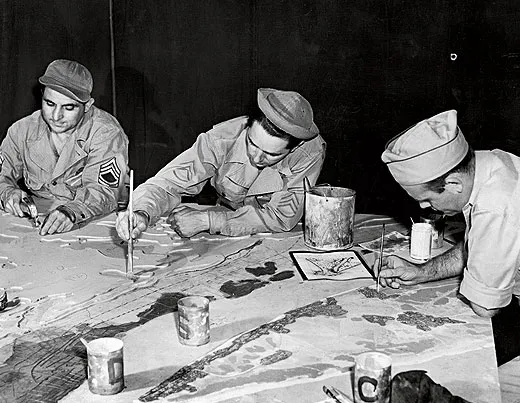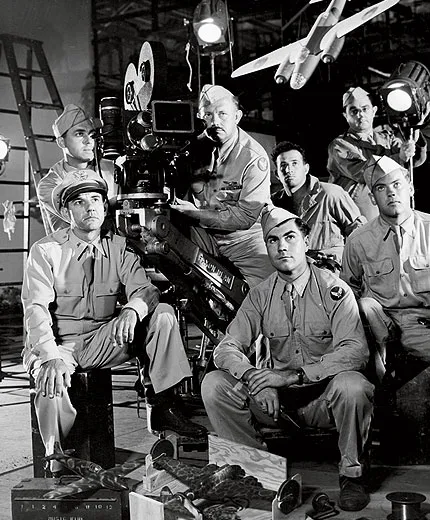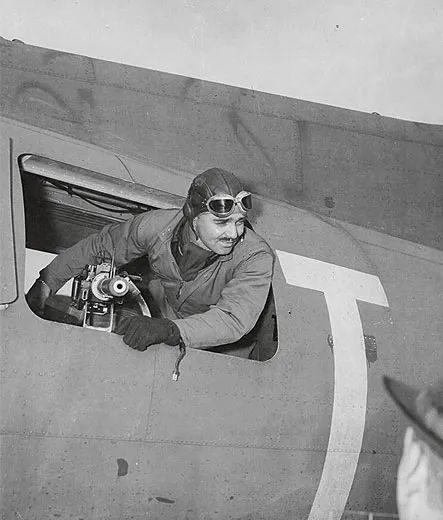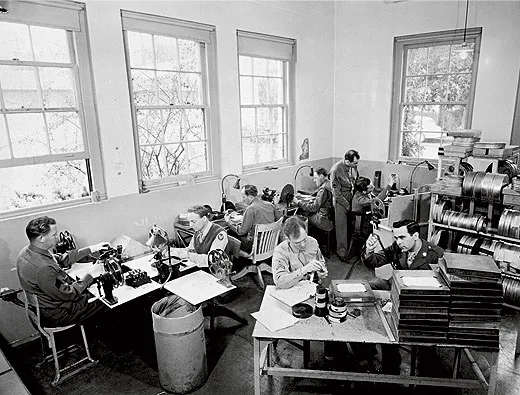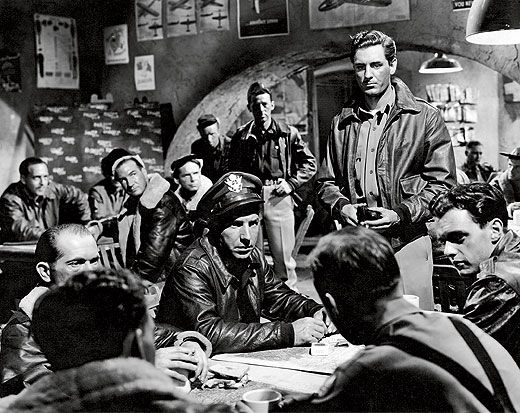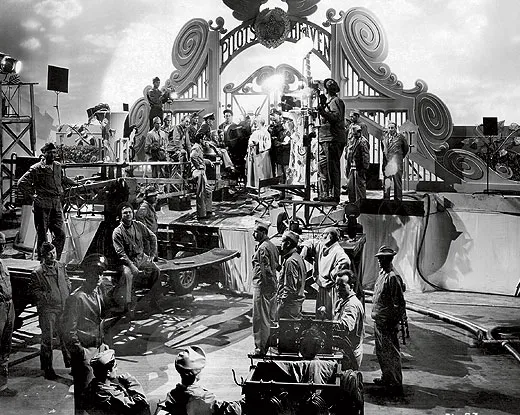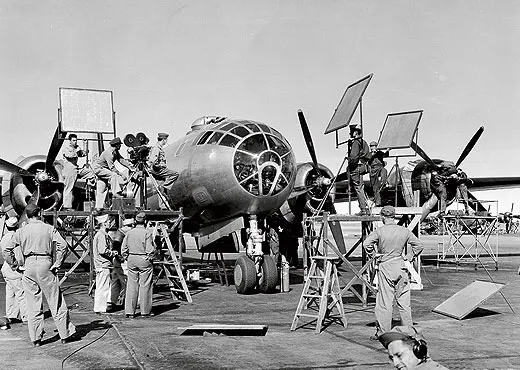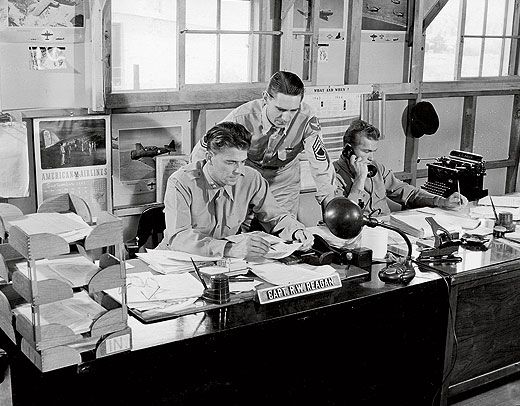World War II: The Movie
When the U.S. Army Air Forces needed 100,000 men to volunteer, General Hap Arnold recruited Hollywood.
/https://tf-cmsv2-smithsonianmag-media.s3.amazonaws.com/filer/World_war_ll_the_movie_03012012_1_FLASH.jpg)
On a Sunday morning in march 1942, the commander of the U.S. Army Air Forces was sitting in his Washington, D.C. office with Jack Warner, vice president of Warner Bros. Studios. The United States had entered World War II the previous December, and Lieutenant General Henry “Hap” Arnold had spent the past four months shaping his air force into one of the most formidable in the world. Anticipating an air war on two fronts on opposite sides of the globe, the service was rolling out tens of thousands of new airplanes. Arnold needed men to fly them.
Arnold wanted 100,000 pilots, and he told Warner he needed a powerful recruitment movie. After that, he’d need effective training films to get all those recruits flying and fighting as soon as possible. To make all these movies, he proposed building a USAAF motion picture unit, staffed entirely with recruits from Hollywood.
Also in the room during that meeting was Owen Crump, a scriptwriter with a reputation, developed during a career in radio, for speed and accuracy. Since before Pearl Harbor, he and Warner had been making propaganda films for the military, intended to promote the armed forces to an American public reluctant to enter the war in Europe. Crump, who died in 1998, recalled the meeting in an interview recorded during 1991 and 1992 by the Academy of Motion Picture Arts and Sciences. He remembered that after Warner agreed to throw his studio’s weight behind the idea, Arnold turned to Crump and said, “You’re in this too”; he promised both men officers’ commissions on the spot.
On the airplane back to Hollywood, Crump wrote the script for Winning Your Wings, the recruitment film Arnold had commissioned; within days, it was in production. John Huston, who had recently made The Maltese Falcon, was brought on to direct it. Actor Jimmy Stewart, an accomplished pilot who had enlisted the previous year, was given orders to star as the film’s on-camera narrator. Stewart took his service in the Air Forces seriously, and thinking the studio had pulled him away for a publicity stunt, he arrived on set irate. Crump took Stewart across the street to a café and explained what he and Warner were up to. Stewart apologized for the blow-up, knocked out his scenes in a few days, and flew back to his post.
Winning Your Wings opens with Stewart flying aerobatics in a BT-13 Valiant trainer, which he then lands and taxis up to the camera. He radiates cool in his leather jacket and aviator sunglasses, and he waxes poetic about the importance of winning the war. The scene cuts to a young actress ditching her ground-bound Army date for a boy with wings on his jacket, as Stewart’s voice-over claims that flyboys always get the girl.
The film played in theaters all over the country—and more than 150,000 men signed up to join the Air Forces.
Requests from Washington for more recruitment movies started to pile up, and Warner and Crump realized the studio wouldn’t be able to satisfy its military obligations on top of its normal production schedule. They decided Crump would put together a separate studio devoted to serving the Air Forces. Warner gave Crump the idle Vitagraph Studios lot, where silent films had been made in the 1910s, and Crump set out to turn it into a military post.
Crump began recruiting from the Hollywood studios. A few other notable filmmakers, like director Frank Capra, had already joined the service (Capra was in the Army Signal Corps, which also made training and propaganda films), and Crump didn’t want all the good talent to enlist before he got his unit off the ground. He put an ad in the trade papers, and by the next day his office was flooded with applications from writers, directors, editors, animators, and composers, many of whom were established professionals willing to take a sizable pay cut to join the war effort. Future best-selling novelist Irving Wallace wrote scripts. Artist Wayne Thiebaud painted sets. Larry Ornstein, a trumpet player for the big bands, recorded the reveille that played each morning on the post public address system.
Several movie stars joined the unit as well: Clark Gable, Lee J. Cobb, William Holden, Arthur Kennedy, Van Heflin, Joseph Cotten, DeForest Kelley, Alan Ladd, and others. Westerns star George Montgomery drove the bus from the barracks to the post. Actor and future president Ronald Reagan, who was already a second lieutenant in the Cavalry Reserve, transferred to the Air Forces to join Crump’s outfit. He was well liked in the movie industry, so Crump made him the unit’s personnel officer and put him in charge of processing incoming recruits.
On July 1, 1942, the outfit was officially named the Army Air Forces First Motion Picture Unit. But Vitagraph was underequipped for full production, and Crump struggled at first just to supply the post with the basics. Luckily, his men were used to improvising. “Motion picture fellows, a lot of them, are very, very good at that,” said Crump, remembering how the men brought whatever was needed from their own homes. “These are the things I’m so proud of, the way the thing got started.”
But the unit still needed a proper studio. As Crump drove past Hal Roach Studios in Culver City, where the Laurel and Hardy and Our Gang films were made, he noticed the lot was out of use (Roach had been conscripted into the Signal Corps in Astoria, New York, forcing him to put his studio’s lineup on hold). The studio had everything the motion picture unit needed: six warehouse-size sound stages, prop rooms, editing bays, costume and makeup departments, even an outdoor set made to look like a city street. Crump called Arnold, and within 11 days the Air Forces had leased the studio and made production manager Sidney Van Keuren a major. Jack Warner, feeling he’d done his part getting the outfit off the ground, went back to running Warner Brothers.
Crump moved his unit from Vitagraph to Hal Roach Studios, which they dubbed Fort Roach. The lot comprised 14 acres and dozens of buildings, most of them windowless to provide the controlled-lighting environments necessary for filming. The exception was a long, narrow two-story building in the front of the lot that contained the post’s production department. Crump moved into Hal Roach’s old office, which was decorated with chandeliers, dark wood paneling, and ornate molding and which, in the studio’s early days, had contained a polar bear pelt.
Aside from the military motor pool in the back of the lot and the fact that everyone was in uniform, Fort Roach looked and functioned like a conventional movie studio. The only thing it didn’t have was a mess hall, so the Army built one. The barracks, which housed the men who didn’t have homes in Los Angeles, were located two miles away, at Page Military Academy.
In addition to their filmmaking work, the men shared KP duty in the mess hall and took turns guarding the studio’s front gate. Each morning they would march in groups down Washington Boulevard to perform calisthenics in the parking lot of the Casa Mañana nightclub. People began to call them the Hollywood Commandos, and the men adopted the motto “We kill ’em with fil’m.”
The unit’s first official project was a training film called Learn and Live. It is set in “Pilot’s Heaven,” where uniformed fliers wearing white angel wings mill around in the afterlife while their instructor tells St. Peter what flying errors they made to end up there.
Not all of the unit’s work was so fanciful. Many of its projects demanded the distillation of complicated details so they could be learned quickly, like the movies the unit made on how to identify enemy aircraft. This training was among the most vital that American airmen received.
In the Pacific, American pilots couldn’t tell the difference between a Japanese Mitsubishi A6M Zero and a U.S. Curtiss P-40 Warhawk, and were shooting down their wingmen. An intact Zero was finally captured in Alaska, and was immediately loaded into a cargo plane and flown to Los Angeles, where unit cameramen were waiting. Within hours the Zero was doing maneuvers over the Californian desert as camera planes filmed it from every angle. The animation department worked through the night to develop a simple way of illustrating the Zero’s distinguishing characteristics. A finished film on how to identify the enemy airplane—complete with a cartoon comparing the fuselage to a cigar—was shipped out to air bases all over the Pacific theater the next day.
Howard Landres and Eugene Marks, now in their late 80s, are among the few alumni of the unit still living. They were childhood friends in Los Angeles, and they were only 19 when they joined the Air Forces as filmmakers. Both were going to college and working part time, Marks as an engineer at a recording studio and Landres in the reading room at MGM. Having heard that the Air Forces had formed a film unit close to home, they jumped at the chance to join. Landres showed up to interview with Lieutenant Reagan on a Thursday (his day off at MGM), and Reagan asked if he would be ready to join the Air Forces the next day.
“I said, ‘Tomorrow’s Friday! I have a date,’ ” Landres remembers. Reagan suggested the following Tuesday, and they had a deal. Marks also asked that his induction be postponed a few days, as he had tickets to a football game.
“You got to remember, this was a Hollywood unit,” says Landres. “Nobody really saluted as an officer passed. I mean, it was so not the military.” Many members of the unit lived at home and commuted to Fort Roach. The men addressed one another by first names, and in their free time they played badminton or volleyball on empty sound stages. All unit recruits were required to go through basic training before reporting to the post, says Landres, “but it wasn’t the basic-basic.”
“It was like, marching up and down the street for 20 minutes,” says Marks.
“How we won the war was not through this unit,” jokes producer Arthur Gardner. “If any real Army officer had come and spent a week there, he’d have been out of his mind.” Gardner, now 101 years old, had been an actor in the 1930 movie All Quiet on the Western Front, and already had an established producing career when he joined.
But there was serious business going on at Fort Roach. Several of the unit’s films were top secret, and during filming and editing, parts of the post were restricted. Marks remembers being issued a sidearm and ordered to accompany a batch of celluloid from the lot to a nearby processing facility. Later he learned the film was part of a briefing on the atomic bomb missions to Hiroshima and Nagasaki.
“We were pretty serious there,” says Landres. “I mean…we were still kids, but it was still a big war. The training films really were important, and they’re pretty well done. Because before that, there was really nothing stimulating when you saw an Army movie for training.”
An example of Fort Roach’s improvement to the military training experience was Resisting Enemy Interrogation, a feature-length thriller about a downed aircrew captured by the Nazis. The script is based on the experiences of two American airmen who had been held and interrogated at a chateau in southern Germany; set designers modeled the interiors of the chateau after the airmen’s memories of the real thing, and took detailed notes on the Germans’ tactics. The set builders even enlarged a postcard of the chateau to use as a backdrop for the opening scene.
Owen Crump remembered that when the film was first assigned, it had a palpable buzz. “Kind of like in a regular motion picture studio,” he said, “sometimes you get involved with a film that everybody, the cameramen, electricians and the gaffers, the cutters, everybody, and the actors, know they got one. Everybody feels it and gets excited.”
The film’s purpose is to show airmen-in-training how wily interrogators can be, and how catastrophic the consequences of talking. It’s riveting to watch. The dialogue, acting, cinematography, and music are all cranked up to Hollywood blockbuster-levels, a quality reflected by the film’s nomination for an Academy Award in 1945 in the category of Best Documentary Feature.
While many of the unit’s early films featured its famous actors onscreen, celebrities like Reagan were eventually used only for voice-over, so as not to distract trainees. Instead, most members of the unit served as actors at one time or another. Crump remembers when a visiting colonel unwittingly saluted an electrician dressed as a one-star general for a scene being shot nearby.
To train bomber crews going to Japan, the art department built a 90- by 60-foot scale model of Japan’s coast. The model was made out of paperboard, paint, plaster, dirt, and fabric; forests were made out of foam that had been put through a grinder. During filming, the camera would “fly” over the model to simulate the exact route of the bomb runs. Pilots returning from Japan said the model was incredibly accurate, even down to the varying colors of the seawater along the shore.
One of the crucial functions of the unit was to train combat cameramen in the use of motion picture cameras on the battlefield. Some of the trainees were Hollywood cinematographers; some were high school kids who had taken photography classes. All had to be taught how to load their own film and, if the need arose, how to develop it in the field. From Culver City, the cameramen would ship out all over the world to record the war. In some cases, footage from the front was sent to Fort Roach for use in its films. The men of the Combat Camera Units saw every type of action—they even trained to use machine guns in case a gunner was hit on a bombing run—and they were just as likely to be killed or wounded as their fighting comrades. Much of the aerial footage of World War II was shot by crews trained at Fort Roach.
While filming the documentary Memphis Belle, Oscar-winning director William Wyler and his camera crew flew in bombers over Europe and saw flak and machine-gun fire up close. Wyler wrote home about the challenges of shooting film at 29,000 feet in an unpressurized, unheated cabin. They had to hug their cameras to keep them from freezing up, and getting a good shot was difficult with the oxygen tanks they had to drag from window to window—while under enemy fire.
Most of the film professionals at Fort Roach never saw that side of the war, though occasionally they came close. Writer/director Stan Rubin, now 94, was sent to the Pacific island of Saipan to document the first B-29 mission to bomb Tokyo. While Rubin waited for the Superfortresses to leave, the Japanese bombed Saipan night after night. No bombs directly threatened the foxhole where he took shelter, but it was the closest he ever came to combat. He remembered his relative safety when interacting with regular servicemen who had seen the fighting first hand. “They were appreciative to a certain extent of what we were doing,” he says. “But it would never live up to those who had been in combat or were about to go into combat.”
According to Crump, the Surgeon General of the Air Forces claimed that a 10-minute film made by the unit could teach his men more about caring for the wounded than he could teach them in a month. In his memoirs, German Field Marshal Wilhelm Keitel wrote of the American military, “Our major miscalculation was in underestimating their quick and complete mastery of film education.” Partly as a result of the training in which the First Motion Picture Unit played such an essential role, more bombers and fighters were in the air over Europe faster than the Germans could organize to repel them.
When the war ended, the unit was disbanded, and Hal Roach Studios was returned to its owner with several million dollars’ worth of improvements, courtesy of the Army Air Forces. The studio went back to making commercial films, but eventually closed. In 1963, it was demolished. Gene Marks became a music editor, and worked on such varied films as The Exorcist and Spaceballs. Donald Meyer, a writer for the unit, went on to pen hundreds of songs, including the Billie Holiday hit “For Heaven’s Sake.” A few of Fort Roach’s filmmakers stayed in the military, and some went on to film the many nuclear bomb tests conducted by the United States throughout the cold war.
When the Germans surrendered in May 1945, General Arnold gave Crump one last task: to travel throughout Europe shooting color film of the impact Arnold’s air force had had. Crump and his crew traveled from city to city, including Berlin, filming the damage done by years of bombing. They recorded the interrogations of top Nazi officials captured after V-E Day. They shot footage of the Nazi concentration camps Ohrdruf and Buchenwald as Allied forces liberated the camps.
Back in California, Ronald Reagan and Technical Sergeant Malvin Wald, a scriptwriter, were among the few people to see the developed film of the camps. “Even though it was a summer day, Reagan came out shivering—we all did,” Wald recalled in a 2002 interview. “We’d never seen anything like that.” Arnold was ultimately unable to procure enough funding from Congress to create a documentary using Crump’s footage, and the unused raw film was interred in archives.
After the war, Crump was asked to stay on to command a new film facility being set up in Florida. The Air Forces brass had been so impressed with the job he’d done at Fort Roach that they offered him the rank of general. But Crump retired his commission and went back to work for Jack Warner.
Crump remembered being on the Warner Brothers lot shooting a civilian movie when two Air Forces officers showed up. They had seen Resisting Enemy Interrogation in training. Overseas, they were shot down and captured in Germany. After the downed airmen had been taken in a very familiar truck, through a very familiar gate, they looked at each other in disbelief. There was the exact same chateau from the movie. “We’d die laughing,” Crump recalled them saying, “because it was just like the movies. We all felt like we were in the movies.”
Crump told them how the film was made, the tricks they’d used, and all the expertise and talent that had gone into it.
When they asked him how he knew so much about it, he didn’t tell them that he’d built the First Motion Picture Unit from scratch, or that he had produced the film that helped them through their captivity. Crump replied only, “Oh, I was in the Air Force too.”
Mark Betancourt is a writer and filmmaker living in Washington, D.C. Owen Crump was interviewed by Douglas Bell, Academy of Motion Picture Arts and Sciences Oral History Program, 1994.
